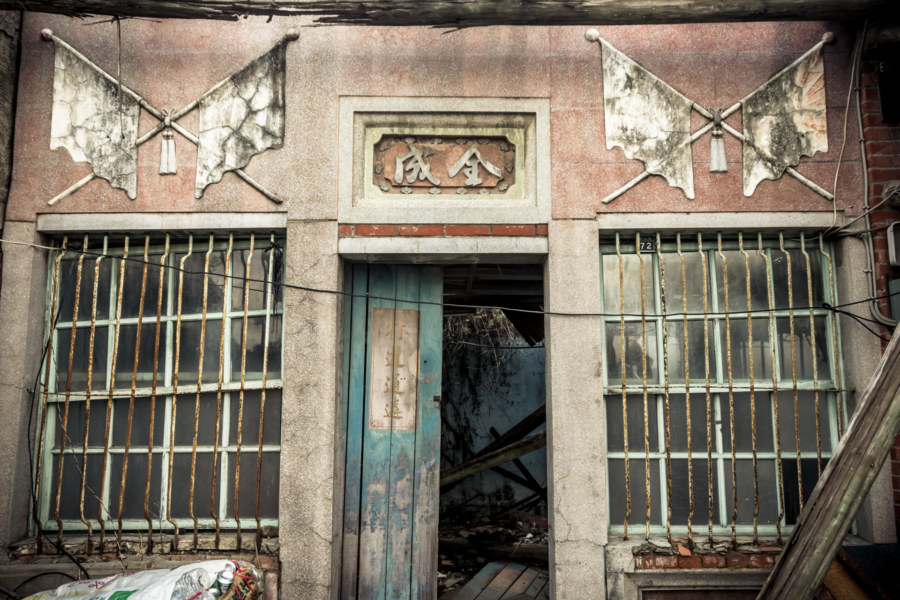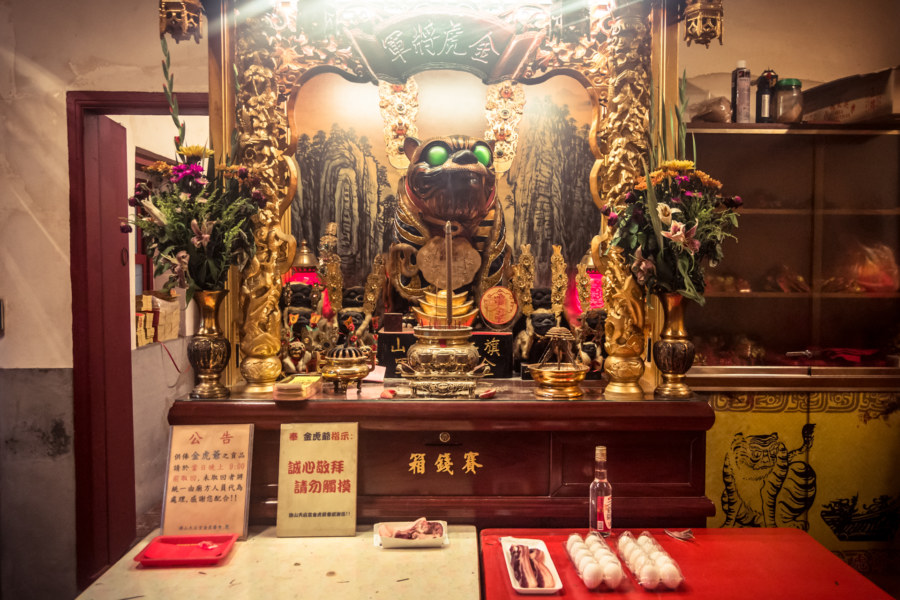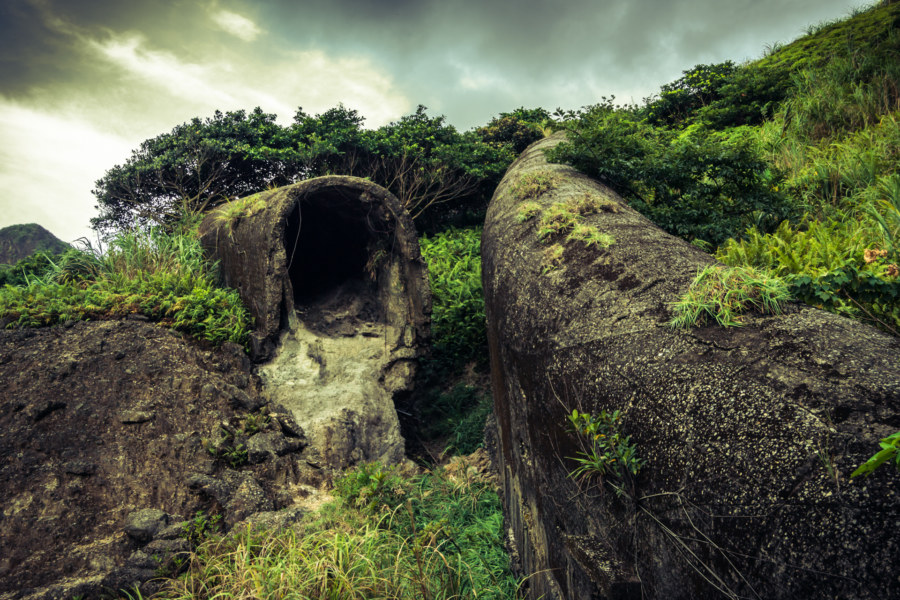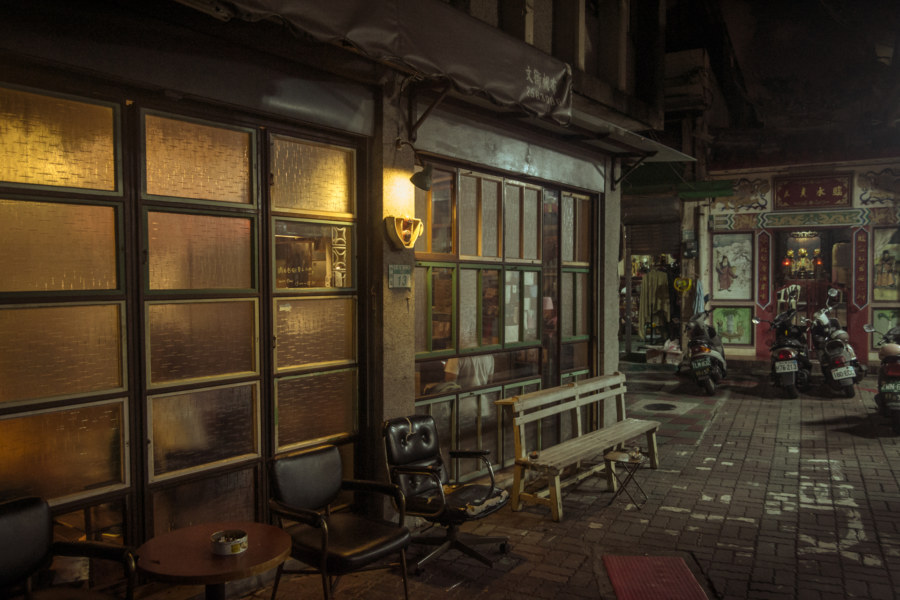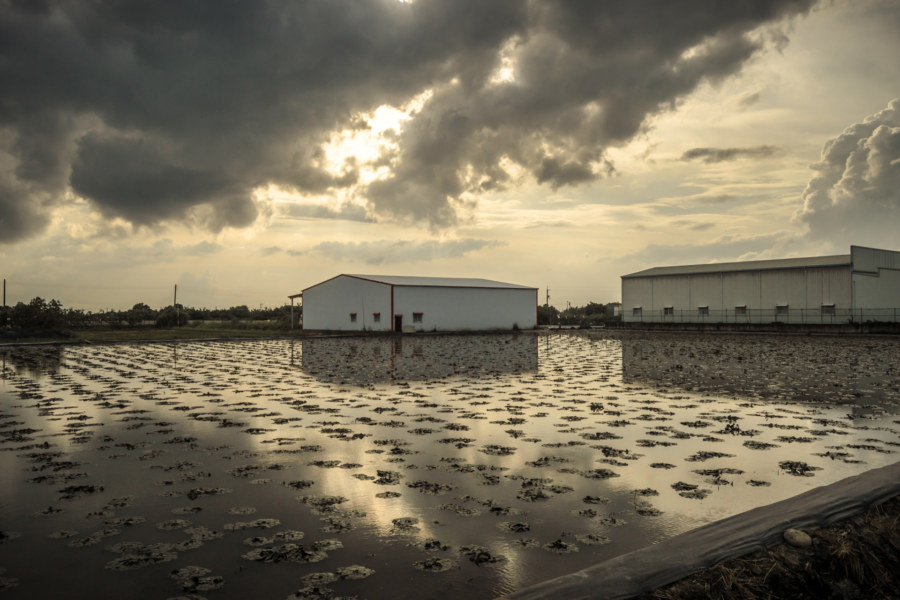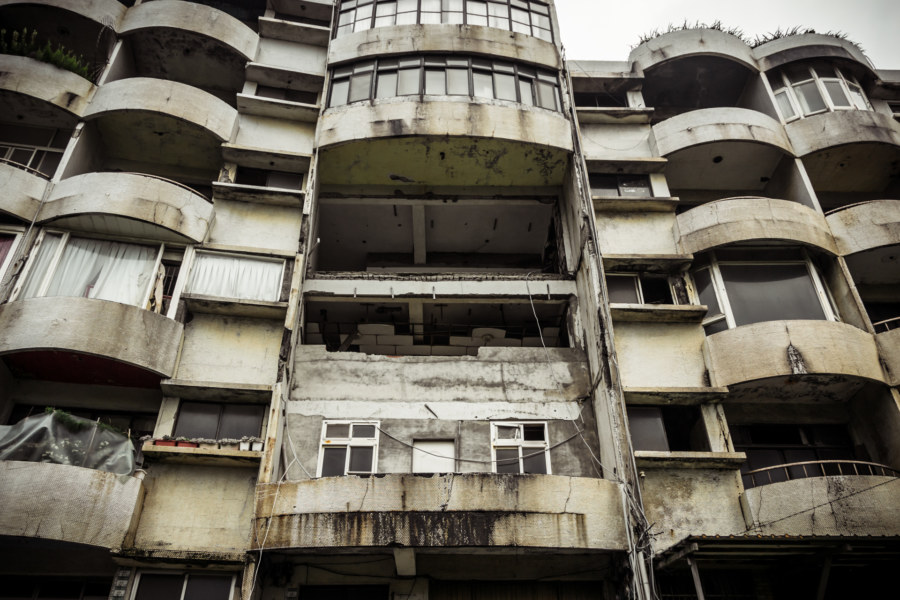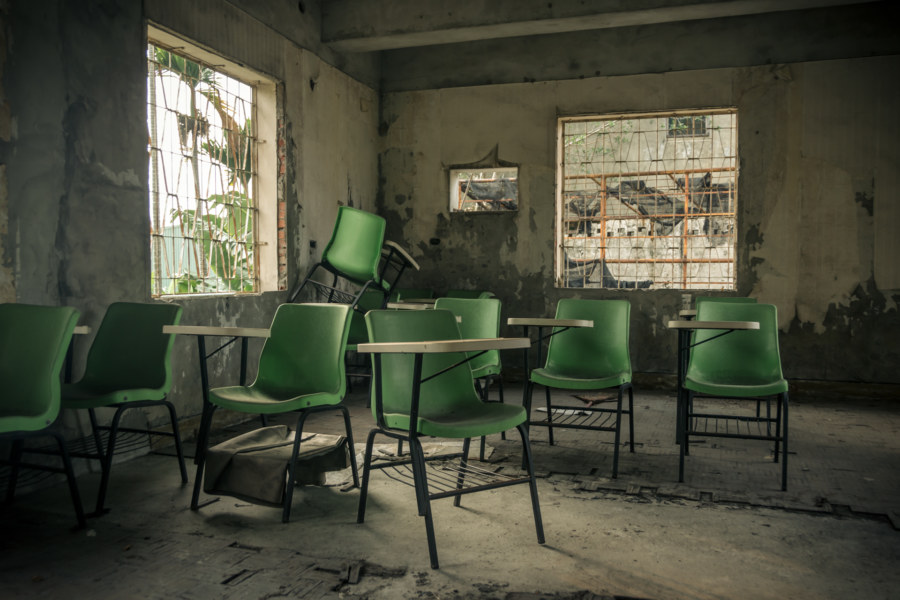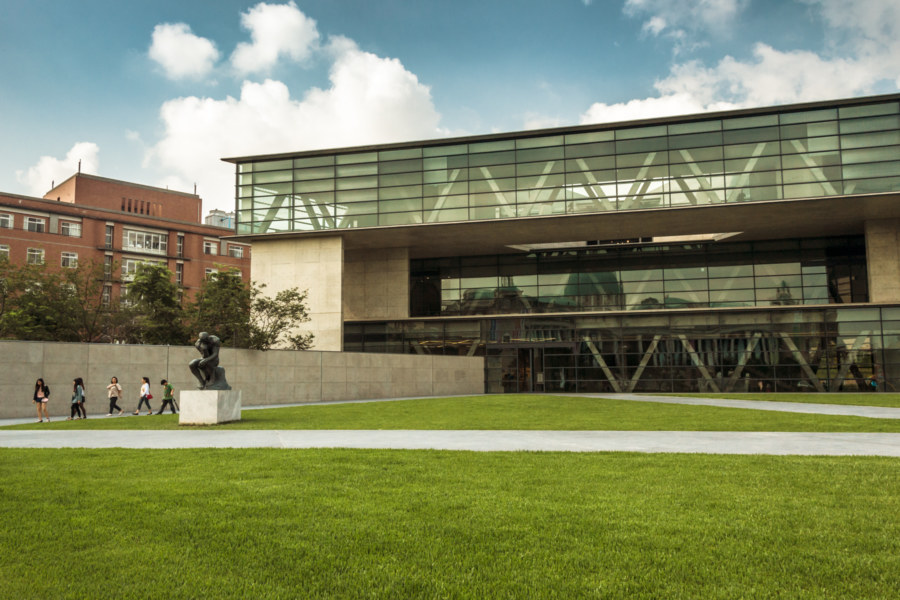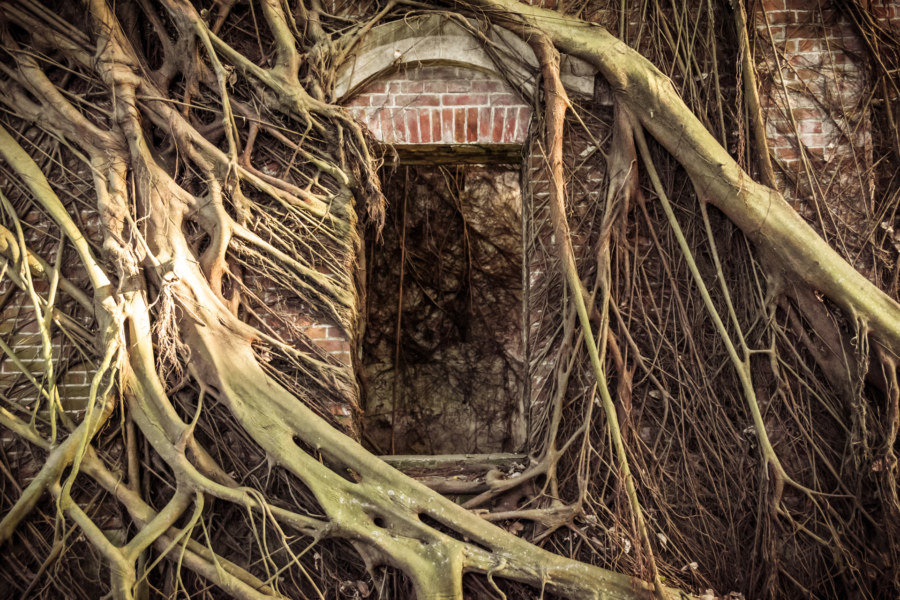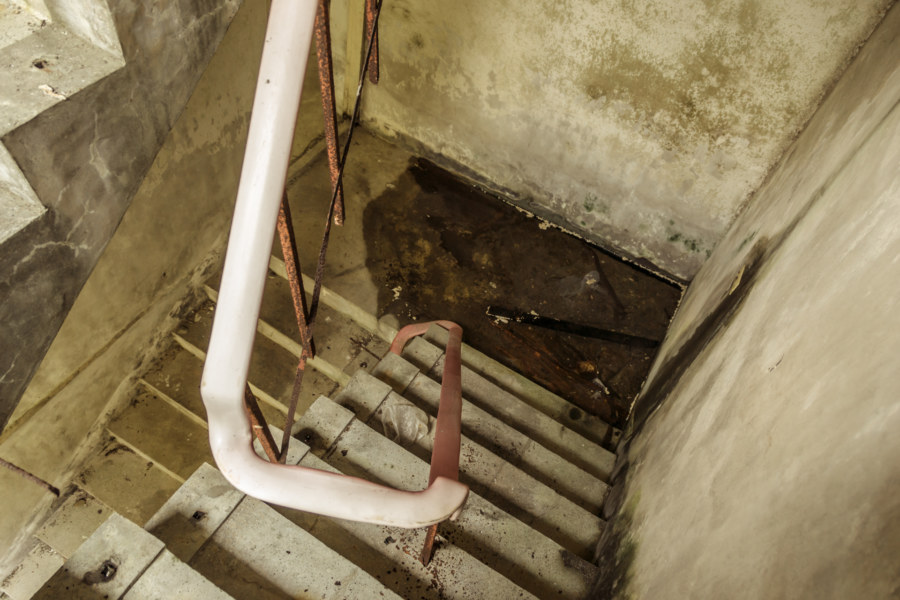I was off the main road in Gūshān Village 姑山里 in Dashu, a hilly rural district in Kaohsiung, when I noticed a row of old buildings next to a small temple. Stopping to investigate, I unslung my camera and snapped a few shots, not quite realizing what I was looking at. My mind was elsewhere—a consequence of two hard days of riding in the tropical summer sun. I was, at the time, heading south to the railway line after making it to Qishan the night before and touring through Meinong earlier in the day. Only later, when I went to develop the photos, did I notice the faint traces of the Japanese rising sun flag in the top right corner of the building pictured above. At one point these stone flags must have been painted bright red, a reflection of Japanese imperial interests in Taiwan.
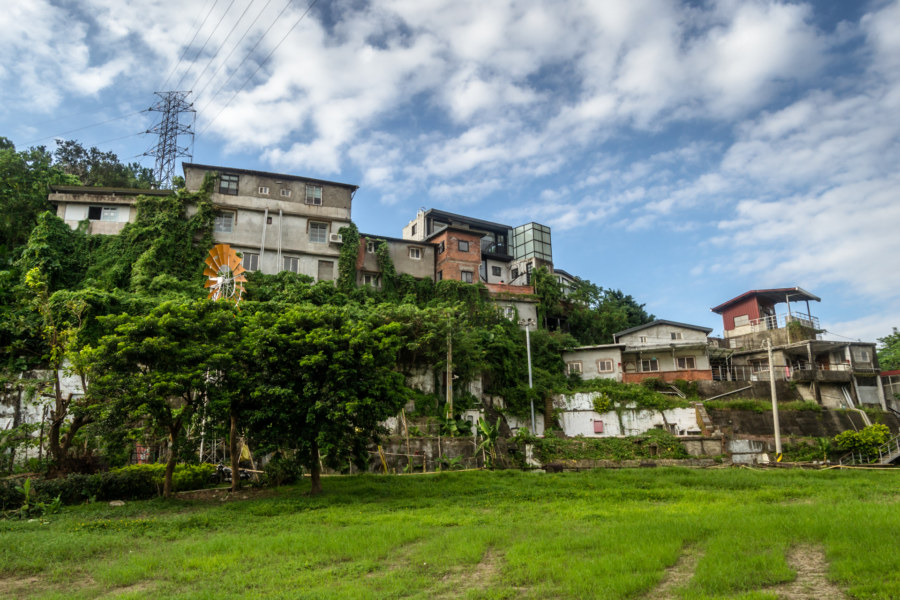
Subterms
The Golden Tiger General of Qishan
After saying farewell to Tainan, where I have been living in for the past three months, I set out by bicycle for Meinong today, but only made it as far as neighbouring Qishan. The long stretch of lonely backcountry roads from Guanmiao to Qishan offered no respite from the relentless sun—and without any place to fuel up I ran out of water high up in the hills, a major no-no in this 35 degree heat. When I finally made it into town I was in no state to be going anywhere—and so here I am, sick with heatstroke in a cheap hotel, but not without at least a small spark of adventure coursing through my veins. I rested for most of the evening so I could go out and grab a bite to eat and see at least a little of this historic town before (hopefully) moving on tomorrow.
Changren Waste Flues 長仁廢煙道
The waste flues of Ruifang are an extraordinary sight. The ruins of these massive, crumbling conduits run for miles up the mountainside from the Shuinandong Smelter 水湳洞精鍊廠 and the rest of the abandoned mining complex below. Originally built during the KMT authoritarian era to transport noxious fumes and waste gases away from the refinery—and nearby settlements like Jīnguāshí 金瓜石—these flues are reputedly the longest in the world.
Tainan Working Cafes
Note: this post still receives a fair amount of traffic but it is very out of date. It was only current back in 2014, when it was published. Keep that in mind when reading these recommendations!
What follows is a short list of serviceable working cafes in and around downtown Tainan. What do I mean by a “working cafe”? I mean a cafe where students, freelancers, and remote workers will find the things they need to dig in for an extended period of time and get some work done. My criteria for a good working cafe: decent coffee, the availability of snacks or light meals, comfortable seating, wireless connectivity, unobtrusive music, reasonable prices, long opening hours, welcoming staff, and an ambiance conducive to creative work, especially programming. Of course, it helps if a cafe looks nice too!
A Long Ride From Tainan to Changhua
I have been working very hard these last few weeks—a little too hard, at times. To break the monotony of laying code every day I elected to go for a proper ride yesterday. Since moving to Tainan I haven’t gone on any long rides whatsoever—so I geared up for a day on the road, preparing for almost any eventuality. I had several destinations in mind such as the badlands to the east of the city but struck out to the north on a whim, intending to make it to at least Chiayi City by sundown.
Harbour City 海灣新城
Harbour City 海灣新城 is an imposing ruin sprawling along the coastline not far from Cape Fugui 富貴角 at the northernmost tip of Taiwan. I first noticed it on my round-the-island bicycle tour last year but did not stop to explore, having already spent much of my daylight riding time poking around the UFO houses of Wanli.
More recently I set out on a two-day urban exploration road trip with a friend from the Netherlands. Late in the afternoon on the first day we were thrown out of an abandoned amusement park in nearby Jinshan. Not having anything better to do with the remaining hour or so of daylight, I suggested we make our way up the coast to Shimen to investigate the ruin I had seen the previous year.
Wufeng Minsheng Clinic 霧峰民生診所
On the way back from the 921 Earthquake Museum 九二一地震教育園區 in early 2014 I noticed an abandoned building at the side of the highway in rural Wufeng. Stopping to investigate, at first I assumed it must have once operated as a bǔxíbān 補習班, or cram school, a common feature of the social landscape here in Taiwan, but that initial hypothesis turned out to be completely wrong. Years later it was brought to my attention that this was originally Mínshēng Clinic 霧峰民生診所, the office of a country doctor by the name of Lín Péngfēi 林鵬飛. He passed away several years ago, leading to the abandonment of the clinic. More recently it was purchased by local farmers, completely renovated, and has reopened as a small museum and community center, the Wufeng Minsheng Story House 霧峰民生故事館.
Asia Museum of Modern Art 亞洲現代美術館
The Asia Museum of Modern Art 亞洲現代美術館 (official site in Chinese) is a strange thing to find amid the rural-industrial sprawl of southern Taichung. Located on the outskirts of historic Wufeng, it is part of the much larger Asia University 亞洲大學 campus, itself riddled with European-inspired architectural curiosities like a gymnasium designed to look like the Colosseum of Rome. The art gallery, straying from the kitsch theme of the rest of the university, is an original design by renowned Japanese architect Tadao Ando. It took nearly seven years to build and opened in 2013.
Minxiong Liu Family Mansion 民雄劉家洋樓
The Liu Family Mansion (劉家古厝) in Minxiong, Chiayi, is one of the most famous ruins in all Taiwan. Situated in the countryside just outside of town, this old Baroque Revival-style red brick building is more informally known as the dreaded Minxiong Ghost House (民雄鬼屋). It was built in 1929 for Liú Róngyù (劉溶裕), a businessman with seven children, and appears to have been abandoned sometime in the early 1950s, not long after the end of Japanese colonial rule.
The Leaning Tower of Su’ao 蘇澳斜塔
There are plenty of crummy old apartment blocks in Taiwan, many of them abandoned and left to the elements. I seldom take more than a cursory look any more since they’re so easy to find—just ride or walk around and look for broken windows and grime. Most of the time there isn’t much to see inside—and anything valuable or interesting has almost always been removed. Even so, I stopped for a moment to investigate this particular building in Su’ao, a township in Yilan, and made an intriguing discovery.
